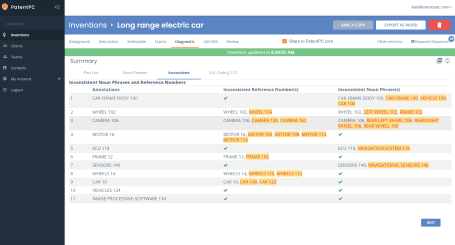AI-Powered Office Action Response Solution
Effortless, Accurate, and Timely Responses to USPTO Office Actions
Reduce Stress. Save Billable Hours. Protect Client Interests.
Why OfficeAction AI?
Our intelligent platform transforms how patent professionals respond to Office Actions
Automated Drafting
Upload your Office Action notice and case file. Our AI instantly analyzes claim rejections, cited art, and examiner reasoning, generating a tailored response draft.
Speed & Accuracy
Dramatically reduce drafting time while maintaining the highest standards. Our algorithms are trained on thousands of successful responses and updated with the latest USPTO practices.
Never Miss a Deadline
Customizable alerts and calendar integration guarantee you stay ahead of statutory deadlines and avoid costly extensions or abandonments.
Seamless Collaboration
Invite colleagues or clients to review, comment, and edit drafts securely. All activity is tracked — from first draft to signature-ready submission.
Privacy-First Design
SOC 2-compliant, encrypted infrastructure keeps your confidential application data and communications safe.
One-Click Formatting
Convert your draft to ready-to-file format with a single click, ensuring compliance with USPTO requirements and saving hours of formatting time.
How It Works
OfficeAction AI employs cutting-edge natural language processing to streamline your Office Action response workflow
Upload Office Action
Simply upload the USPTO Office Action notice and your case materials through our secure interface.
AI Analysis
Our AI engine analyzes rejection types, examiner arguments, cited prior art, and claim language to identify optimal response strategies.
Draft Generation
Within minutes, receive a comprehensive draft response with arguments tailored to your specific case, complete with relevant legal citations.
Review & Edit
Our intelligent editor allows you to refine the response, collaborate with colleagues, and finalize with your professional expertise.
Export & Submit
Generate USPTO-compliant documents ready for submission, saving hours of formatting and administrative work.
Work Smarter, Bill Better
OfficeAction AI isn't here to replace your expertise — we amplify it. Spend less time on repetitive drafting and more time on strategy, client advice, and portfolio management.
Solo Practitioners
Automate your office action workflow and scale your practice without adding staff. Respond to more office actions in less time.
Law Firms
Centralize case management, improve collaboration between attorneys, and optimize resource allocation for better client outcomes.
In-House Counsel
Respond faster to office actions with greater consistency and auditability. Maintain institutional knowledge in a central system.
OfficeAction Word Plugin
Seamlessly integrate our AI tools directly into your Microsoft Word workflow
Native Integration
Work directly within Word where you draft your responses, eliminating the need to switch between applications.
One-Click Response
Select rejection text and generate targeted responses with a single click, all within your document.
Format Preservation
AI-generated responses maintain proper USPTO formatting and citation styles automatically.
Installation is Easy
- 1Sign up for an OfficeAction AI account
- 2Download the Microsoft Word plugin from your dashboard
- 3Run the installer and follow the prompts
- 4Open Word and log in with your OfficeAction AI credentials
Compatible with Microsoft Word 2016 and newer on Windows, and Word 2019 and newer on macOS
Enterprise Integration Options
Need custom deployment options for your firm? Our enterprise solutions include SSO integration, private cloud deployments, and custom document template support.Contact our sales team to learn more.
Experience the Future of Patent Prosecution Today
Join top patent professionals who have streamlined their Office Action process with OfficeAction AI. Try it risk-free with our 14-day trial.
Request a Demo
What Patent Professionals Say
Hear from attorneys and agents who have transformed their Office Action response process
"OfficeAction AI has cut my Office Action response time in half. The AI-generated arguments are impressively on-point, and I can focus more on strategy rather than routine drafting."
"As a solo practitioner, OfficeAction AI has been a game-changer. I can handle more cases without sacrificing quality, and the deadline management features ensure I never miss a filing date."
"Our firm has seen a 40% reduction in time spent on Office Action responses. The collaboration features make it easy for partners to review associate work, and clients love the faster turnaround times."
Frequently Asked Questions
Get answers to common questions about OfficeAction AI
Yes. All output is structured in line with USPTO requirements and can be reviewed/edited as needed. Our system stays current with USPTO format requirements and automatically applies the correct formatting to your responses.
Absolutely not. OfficeAction AI provides high-quality drafts and suggestions — final review and decisions remain in your hands. Think of it as an extremely efficient first-draft generator that helps you focus your expertise on strategy and refinement.
We use enterprise-grade encryption and never share your data. Full confidentiality is contractually ensured. Our SOC 2 compliance means we follow rigorous security protocols, and we implement zero-knowledge encryption where possible to protect your sensitive client information.
Our AI models are trained on thousands of successful Office Action responses and continuously updated with the latest USPTO decisions and guidelines. While no AI is perfect, our customers report approximately 85-90% accuracy on first drafts, with subsequent versions improving through your feedback and edits.
OfficeAction AI offers API integration with popular docketing systems and practice management software including Foundation IP, PatentCenter, and FoundationIP. Our team can assist with custom integrations for Enterprise customers.
OfficeAction AI is trained to handle all common rejection types including 101 (subject matter eligibility), 102 (anticipation), 103 (obviousness), and 112 (indefiniteness, enablement, written description) rejections. The system is particularly effective at developing arguments against obviousness rejections by identifying gaps in examiner reasoning.
